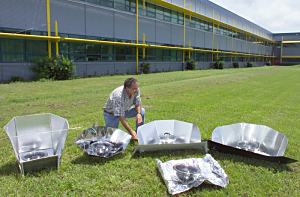
FSEC Helps Develop More Efficient and Durable Solar Cooker
Most research centers like FSEC depend on contracts and external funding to conduct their programs, and the image of a scientist pursuing grants as aggressively as pursuing his own research interests isn’t too far from what often goes on.
Sometimes, though, these same centers get involved in activities that don’t bring in any money, but provide societal benefits that make the projects more than worthwhile.
One such project at the Florida Solar Energy Center started five years ago when Philip Fairey got a phone call from Darwin Curtis, one of the founders of Solar Household Energy, Inc. (SHE). Curtis had lived in a number of places around the world during his career in foreign service, and he was a strong advocate of the use of solar cookers in societal development and environmental protection.

John Harrison arranges several of the cooker prototypes that will be used for outdoor comparisons. Note the HotPots in the cookers.
(Photo credit: Nick Waters)
The SHE organization was established to introduce solar cooking “where it can add quality of life and relieve stress on the environment,” and he was looking for someone to help him develop a more durable, lower-priced solar cooking system that would simply work better than the models currently being used. Curtis explains that “we presented FSEC with an engineering problem that we thought might be insolvable.”
That was the type of challenge Fairey enjoys. Though there was only a very small grant available from the Dorothy Ann Foundation to do all of the research he was interested in, Fairey thought this would be a great project for FSEC to help with, and he put together a team of FSEC staff members that could help pursue this project.
John Harrison, who headed up the materials and construction research component of the project, explained that “we immediately decided to pursue two different avenues of improving the cookers’ efficiency and bringing down their cost. One was to investigate the best type of reflector and reflective materials that would concentrate the sun’s rays on the food, and the second was to possibly come up with a cooker design that would cook the food faster and better.”
Most solar cookers use reflectors that are low cost and made of materials like cardboard that just don’t hold up over time. Most of the units the researchers looked at deteriorated over time due to their constant use and the impact of humidity and moisture. Harrison and his colleagues put together a number of reflector components, trying to find the best ones that would be flexible, could be easily stored and shipped, and would be durable. They eventually selected a design that used corrugated plastic and met their needed criteria, especially for durability. Center staff developed schematic drawings of a prototype cooker and provided them to the SHE staff for production.
The team realized that the reflector material was only part of the need, though. “What became clear was that we needed not only reflectors that were sturdier, but also that simply performed better optically. Having an optics person like Ross McCluney on staff made it easier for us to pursue this strategy.” McCluney considered a number of ideas for creating a better reflector that would work more efficiently, and came up with an improved design that greatly improved the performance of a cooker.
The other part of the FSEC project, developing some type of cooker for the food, also proved challenging. People using solar cookers typically put their food in sealed plastic bags into conventional cooking pots, both covered and uncovered. The FSEC researchers decided to investigate Fairey’s idea of a “greenhouse” type of cooking apparatus — essentially putting a metal pot into a glass bowl and sealing it with a glass lid, creating a greenhouse effect. A number of different concepts and designs were created and investigated. Tests were conducted by Mark Thornbloom on several reflector designs using the new cooker design. Specific plans and schematics for the construction of the bowl — now called a HotPot by SHE — were developed. The chosen design maintained a great deal of heat and held it well for cooking purposes.
A final report on the project was submitted, the SHE organization ordered cooking pots from a manufacturer in Mexico, and the project was completed. Almost.
Curtis called again recently and requested further evaluation from Fairey and Harrison. FSEC offered to do some pro-bono side-by-side tests using four HotPots to determine if any one reflector design is significantly better than another or if the real key to the system is the HotPot design itself. Neil Moyer volunteered to help the FSEC team with this new research and help conduct monitoring experiments.
According to Curtis, FSEC’s work on this project will make a difference in the lives of people around the world. “The task I gave FSEC was to design a simple, easy-to-use, durable, efficient, portable and appealing solar oven for the developing world. That’s not all. It had to be cheap. FSEC’s elegant solution was sent in prototype to experts around the world for appraisal. It received high marks from potential customers on four continents as well as from such engineering centers as the Cooper-Hewitt Foundation in New York. Now in mass production, its distribution has begun in North and South America as well as in Africa.” He emphasizes that “there are millions in the developing world with urgent need for alternative household fuel. The engineering of FSEC has put important technology in their reach.”
The activities conducted and the reports provided for SHE can be seen at http://www.fsec.ucf.edu/en/research/solarthermal/solar_cooker/.
This is the kind of project that normally doesn’t get much public attention, but it leaves everyone working on it feeling pretty good about what they’re doing. Money can’t buy that kind of reward.



